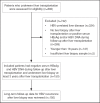Significance of detectable hepatitis B virus DNA in liver allograft tissue in long-term follow-up of liver transplant recipients
- PMID: 35783904
- PMCID: PMC9138924
- DOI: 10.14744/hf.2021.2021.0003
Significance of detectable hepatitis B virus DNA in liver allograft tissue in long-term follow-up of liver transplant recipients
Abstract
Background and aim: The objective of this study was to evaluate the long-term presence of hepatitis B virus (HBV) DNA in the liver grafts of liver transplant patients who received hepatitis B immunoglobulin (HBIg) plus oral antiviral hepatitis B virus prophylaxis and had negative HBV serum markers.
Materials and methods: Patients aged 18 years or older who underwent liver transplantation for HBV-related liver disease, had negative serum viral markers, and had a liver biopsy at least 3 years after liver transplantation were eligible for this study. Clinical, serological, and pathological data were retrospectively obtained from medical records. The HBV DNA of liver biopsy specimens was assessed using the polymerase chain reaction technique.
Results: A total of 150 patients were included. A positive HBV DNA result was seen in 18 (12%) of the liver biopsies. The presence of intrahepatic HBV DNA was not associated with pre-transplantation serum viral markers, type of pre- or post-transplantation antiviral treatment, or post-transplantation immunosuppressive treatment.
Conclusion: The findings suggest that while treatment with HBIg plus oral antiviral as post-transplantation HBV prophylaxis may result in a percentage of patients with persistent HBV DNA in the graft, the presence of HBV DNA in the liver graft may not be related to clinical HBV recurrence.
Keywords: Hepatitis B virus; liver failure; liver transplantation.
© Copyright 2021 by Hepatology Forum - Available online at www.hepatologyforum.org.
Conflict of interest statement
Conflict of Interest: The authors have no conflict of interest to declare.
Figures
Similar articles
-
Early intrahepatic recurrence of HBV infection in liver transplant recipients despite antiviral prophylaxis.JHEP Rep. 2023 Mar 10;5(6):100728. doi: 10.1016/j.jhepr.2023.100728. eCollection 2023 Jun. JHEP Rep. 2023. PMID: 37122357 Free PMC article.
-
Recurrence-free long-term survival after liver transplantation for hepatitis B using interferon-alpha pretransplant and hepatitis B immune globulin posttransplant.Ann Surg. 1997 Sep;226(3):356-65; discussion 365-8. doi: 10.1097/00000658-199709000-00015. Ann Surg. 1997. PMID: 9339942 Free PMC article. Clinical Trial.
-
Improved clinical outcomes with liver transplantation for hepatitis B-induced chronic liver failure using passive immunization.Ann Surg. 1998 Jun;227(6):841-50. doi: 10.1097/00000658-199806000-00007. Ann Surg. 1998. PMID: 9637547 Free PMC article.
-
Efficacy and effectiveness of anti-HBV therapy with early withdrawal of HBIG prophylaxis to prevent HBV recurrence following liver transplantation.Expert Opin Biol Ther. 2015 May;15(5):665-77. doi: 10.1517/14712598.2015.1025045. Expert Opin Biol Ther. 2015. PMID: 25865452 Review.
-
Antiviral prophylaxis against hepatitis B recurrence after liver transplantation: Current concepts.Liver Int. 2021 Jul;41(7):1448-1461. doi: 10.1111/liv.14860. Epub 2021 Mar 12. Liver Int. 2021. PMID: 33656809 Review.
References
-
- World Health Organization . Geneva: World Health Organization; 2017. Global Hepatitis Report 2017.
-
- McMillan JS, Shaw T, Angus PW, Locarnini SA. Effect of immunosuppressive and antiviral agents on hepatitis B virus replication in vitro. Hepatology. 1995;22(1):36–43. - PubMed
-
- Degos F, Lugassy C, Degott C, Debure A, Carnot F, Theirs V, et al. Hepatitis B virus and hepatitis B-related viral infection in renal transplant recipients. A prospective study of 90 patients. Gastroenterology. 1988;94:151–156. - PubMed
-
- Perrillo RP, Gish R, Falck-Ytter YT. American Gastroenterological Association Institute technical review on prevention and treatment of hepatitis B virus reactivation during immunosuppressive drug therapy. Gastroenterology. 2015;148(1):221–244. .e3. - PubMed
LinkOut - more resources
Full Text Sources

